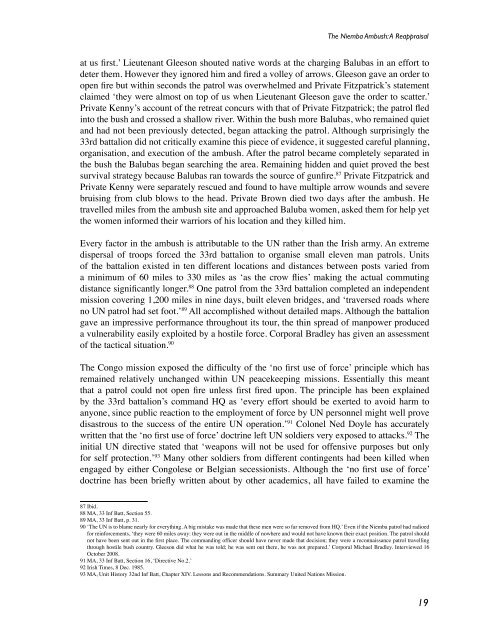Defence Forces Review 2010
Defence Forces Review 2010
Defence Forces Review 2010
You also want an ePaper? Increase the reach of your titles
YUMPU automatically turns print PDFs into web optimized ePapers that Google loves.
The Niemba Ambush: A Reappraisalat us first.’ Lieutenant Gleeson shouted native words at the charging Balubas in an effort todeter them. However they ignored him and fired a volley of arrows. Gleeson gave an order toopen fire but within seconds the patrol was overwhelmed and Private Fitzpatrick’s statementclaimed ‘they were almost on top of us when Lieutenant Gleeson gave the order to scatter.’Private Kenny’s account of the retreat concurs with that of Private Fitzpatrick; the patrol fledinto the bush and crossed a shallow river. Within the bush more Balubas, who remained quietand had not been previously detected, began attacking the patrol. Although surprisingly the33rd battalion did not critically examine this piece of evidence, it suggested careful planning,organisation, and execution of the ambush. After the patrol became completely separated inthe bush the Balubas began searching the area. Remaining hidden and quiet proved the bestsurvival strategy because Balubas ran towards the source of gunfire. 87 Private Fitzpatrick andPrivate Kenny were separately rescued and found to have multiple arrow wounds and severebruising from club blows to the head. Private Brown died two days after the ambush. Hetravelled miles from the ambush site and approached Baluba women, asked them for help yetthe women informed their warriors of his location and they killed him.Every factor in the ambush is attributable to the UN rather than the Irish army. An extremedispersal of troops forced the 33rd battalion to organise small eleven man patrols. Unitsof the battalion existed in ten different locations and distances between posts varied froma minimum of 60 miles to 330 miles as ‘as the crow flies’ making the actual commutingdistance significantly longer. 88 One patrol from the 33rd battalion completed an independentmission covering 1,200 miles in nine days, built eleven bridges, and ‘traversed roads whereno UN patrol had set foot.’ 89 All accomplished without detailed maps. Although the battaliongave an impressive performance throughout its tour, the thin spread of manpower produceda vulnerability easily exploited by a hostile force. Corporal Bradley has given an assessmentof the tactical situation. 90The Congo mission exposed the difficulty of the ‘no first use of force’ principle which hasremained relatively unchanged within UN peacekeeping missions. Essentially this meantthat a patrol could not open fire unless first fired upon. The principle has been explainedby the 33rd battalion’s command HQ as ‘every effort should be exerted to avoid harm toanyone, since public reaction to the employment of force by UN personnel might well provedisastrous to the success of the entire UN operation.’ 91 Colonel Ned Doyle has accuratelywritten that the ‘no first use of force’ doctrine left UN soldiers very exposed to attacks. 92 Theinitial UN directive stated that ‘weapons will not be used for offensive purposes but onlyfor self protection.’ 93 Many other soldiers from different contingents had been killed whenengaged by either Congolese or Belgian secessionists. Although the ‘no first use of force’doctrine has been briefly written about by other academics, all have failed to examine the87 Ibid.88 MA, 33 Inf Batt, Section 55.89 MA, 33 Inf Batt, p. 31.90 ‘The UN is to blame nearly for everything. A big mistake was made that these men were so far removed from HQ.’ Even if the Niemba patrol had radioedfor reinforcements, ‘they were 60 miles away: they were out in the middle of nowhere and would not have known their exact position. The patrol shouldnot have been sent out in the first place. The commanding officer should have never made that decision; they were a reconnaissance patrol travellingthrough hostile bush country. Gleeson did what he was told; he was sent out there, he was not prepared.’ Corporal Michael Bradley. Interviewed 16October 2008.91 MA, 33 Inf Batt, Section 16, ‘Directive No.2.’92 Irish Times, 8 Dec. 1985.93 MA, Unit History 32nd Inf Batt, Chapter XIV. Lessons and Recommendations. Summary United Nations Mission.19
















